Wondering about the diversity in the bee kingdom? Discover the intriguing possibility of red bees, their genetics, and their unique communication.

Can Bees Be Red?
Did you know there are more than 20,000 different species of bees worldwide? That's quite a diversity!
Still, you're probably most familiar with the typical yellow and black striped variety.
Now, here's a curveball – consider the possibility of a red bee. It's not as outlandish as it may sound, and it's a fascinating topic that goes beyond mere aesthetics, touching on genetics, species diversity, and even bee communication.
So, are you ready to explore this unexpected aspect of the buzzing world of bees?
Key Takeaways
- There are over 20,000 different species of bees worldwide, each with varying colors, sizes, and behaviors.
- Bees use color cues to communicate with each other, including sharing the location of food sources and the queen bee using color to indicate dominance and fertility status.
- Bee coloration is determined by genetics and alleles, with multiple alleles interacting to produce the final color. The environment can also influence gene expression and affect bee coloration.
- Red bees have been observed in nature when bees ingest substances like red dye, highlighting the adaptability of bees and the impact of human activities on their coloring. Red bees can raise public awareness about the importance of diverse bee populations and inform conservation strategies.
Understanding Bee Species Diversity
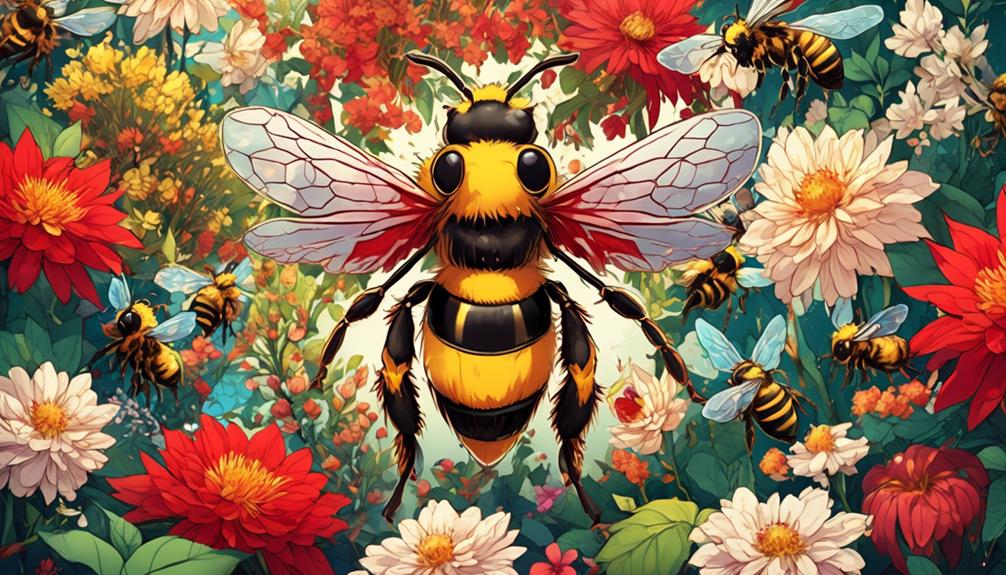
To fully grasp the astonishing diversity among bee species, you'll need to delve into the myriad of colors, sizes, and behaviors that distinguish each type. You'll find an array of bees, from minuscule sweat bees barely visible to the naked eye, to the substantial carpenter bees, boasting a size equivalent to a human thumb. Colors vary too, from the classic yellow and black bumblebee, to the blue, green, and even red hues seen in some exotic species.
Understanding bee behavior is equally as crucial. Social behavior varies dramatically, with some species like honeybees living in complex, organized hives, while solitary bees like mason bees live alone. The way they collect pollen also differs. Some bees, like the honeybee, store pollen in 'baskets' on their legs, while others, like leafcutter bees, carry it on their abdomen.
Colors and Bee Communication
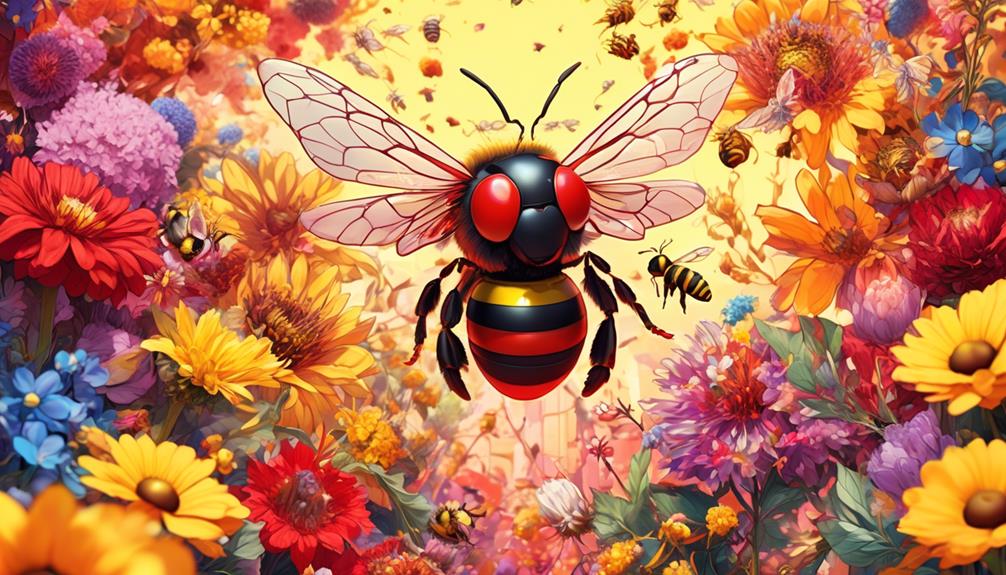
Delving into the realm of colors in the bee world, it's not just about aesthetic variety, but also a key aspect of their communication process. Bees perceive colors differently than you do. They see in ultraviolet light, a spectrum invisible to the human eye. This unique vision enables them to detect patterns and hues on flowers that you can't see, guiding them directly to nectar sources.
Bee communication is largely dependent on color signals. They use color cues to share the location of food sources with their hive mates through a behavior known as the 'waggle dance'. Also, the queen bee uses color to communicate her dominance and fertility status to the rest of the hive.
However, bees can't see red. They perceive this color as black, which could be why you don't often find red flowers being visited by bees. This might seem odd considering the vibrancy of red, but it's all about the bee's specific color vision.
In answering the question 'Can bees be red?', it's essential to consider how their color perception influences their behavior. While they may not physically appear red, the understanding of color in their communication might offer some intriguing insights.
The Role of Genetics in Bee Coloring
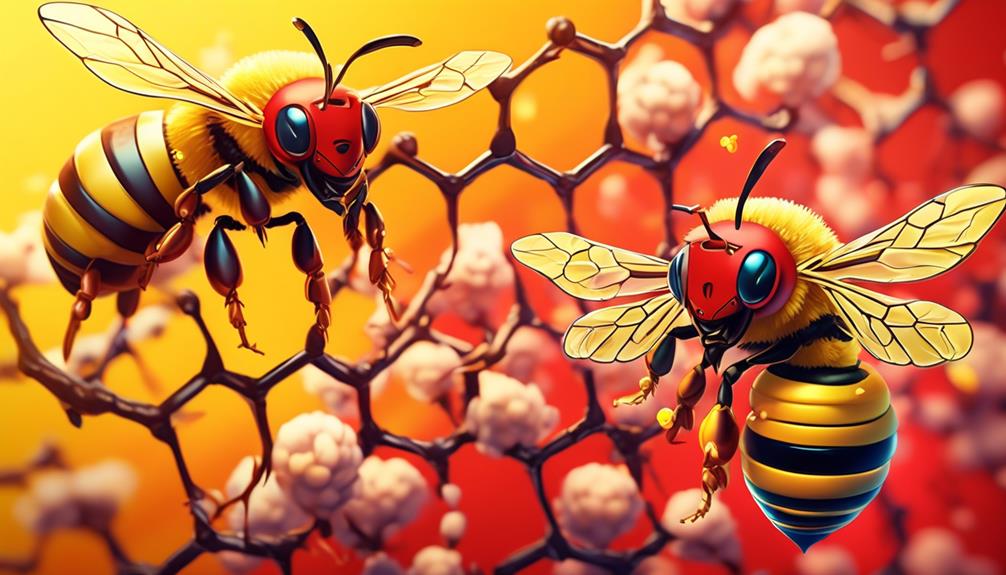
While bees' perception of red impacts their behavior, it's your understanding of genetics that will help you grasp the intricate coloring of these fascinating insects. The coloration of bees is largely determined by their genetic makeup, specifically through the variation in their genes. Within these genes, you'll find different alleles, or genetic variants, that code for various traits, including color.
Each bee's color is determined by the alleles it inherits from its parents, and these alleles can vary greatly, resulting in a wide range of colors. The same gene can have multiple alleles, and the interaction between these alleles influences the bee's final color. It's not as simple as one allele equals one color, though. It's more like a genetic recipe, where multiple alleles combine to produce the final result.
Moreover, the environment can also affect a bee's coloration. For instance, temperature and diet can influence gene expression, leading to changes in color. So, while it's unlikely you'll find a naturally red bee, the role of genetics in bee coloring is a complex interplay between inherited traits and environmental influences.
Understanding this can help you appreciate the diversity and adaptability of these vital pollinators.
Case Study: Red Bees in Nature
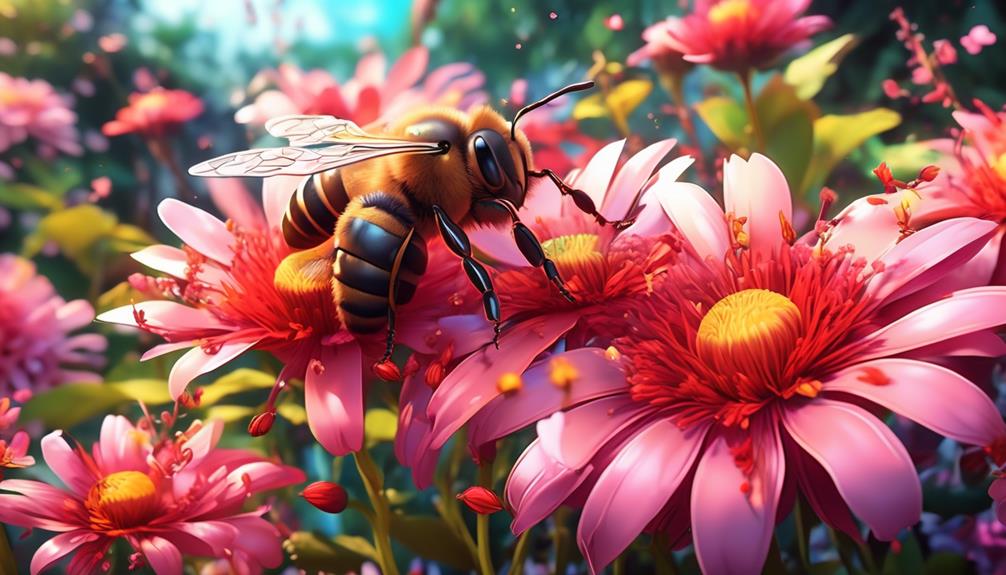
Have you ever come across a red bee in nature? It might seem like an odd sight, but red bees do exist. They're not your typical honeybee, but a result of a fascinating phenomenon that occurs when bees ingest certain substances, like red dye from maraschino cherries.
These anomalous sightings were first reported in Brooklyn, New York, where beekeepers noticed their bees turning red. An investigation found that the bees had been feasting on maraschino cherry juice from a local factory.
To illustrate this phenomenon, consider the following table:
Brooklyn Bees | Typical Honeybees | |
|---|---|---|
Color | Red | Yellow/Brown |
Diet | Maraschino Cherry Juice | Nectar/Pollen |
Habitat | Urban Area | Rural/Wild Areas |
The red color doesn't harm the bees, but it's a stark reminder of how human activities can impact nature, even in ways we might not expect. So, if you spot a red bee, you're witnessing a unique interaction between human industry and the natural world. It's a testament to the adaptability of these remarkable insects and a wake-up call to be more mindful of our actions and their potential consequences.
Implications for Bee Conservation Efforts
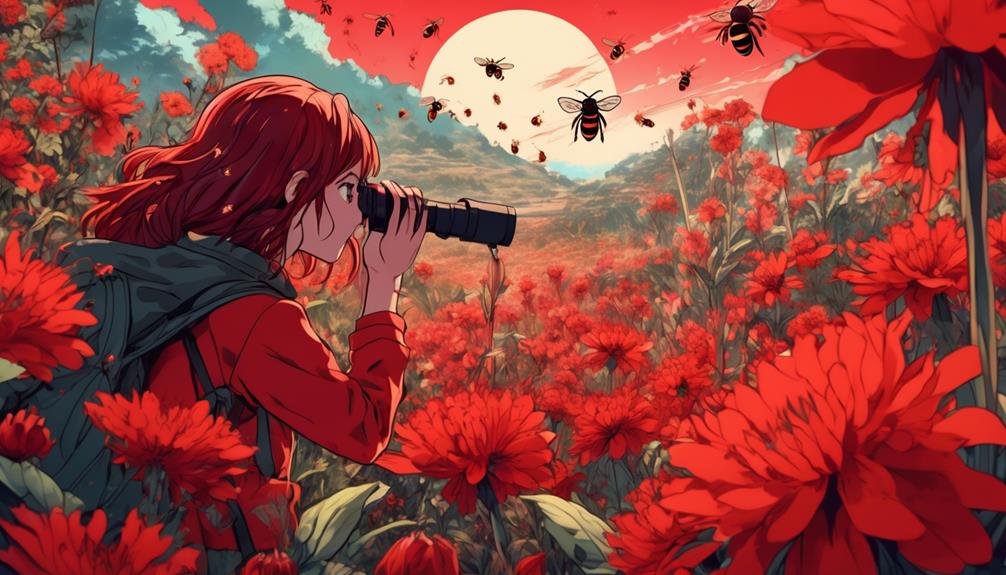
Examining the impact of these red bees, you'll find that they present both challenges and opportunities for ongoing bee conservation efforts. The distinctive red coloration could make these bees more noticeable to predators, potentially increasing their vulnerability. Yet, this coloration might also serve as an effective deterrent, with predators associating the red color with danger or distaste.
In terms of conservation, the existence of red bees presents an opportunity to raise public awareness about the importance of diverse bee populations. The unusual color could spark curiosity and interest, leading to increased support for conservation initiatives. However, a focus on these visually striking bees shouldn't overshadow the need to protect all bee species.
Moreover, understanding the genetic basis of the red coloration could provide insights into bee evolution and adaptation. This knowledge could inform conservation strategies, particularly in response to environmental changes. However, there's also the risk that intervention could inadvertently alter bee populations, disrupting ecological balance. Therefore, it's crucial that conservation efforts are guided by rigorous scientific research and ethical considerations.
Ultimately, the discovery of red bees underscores the complexity of bee conservation and the need for nuanced, adaptive strategies.
Frequently Asked Questions
Can Bees See in the Color Red?
You're asking if bees can see the color red. Interestingly, they can't. Bees' vision is attuned to ultraviolet light, which means they see in the blue and green spectrum, but not red.
However, they can see 'bee's purple', a mix of yellow and ultraviolet light, which is invisible to us. So, while a red flower might look black to a bee, they're attracted to the ultraviolet patterns that these flowers often have.
How Does the Color of Bees Affect Their Survival in the Wild?
The color of bees directly impacts their survival. Bees' coloration can deter predators, with darker colors often acting as a warning sign. They're also influenced by their environment, adapting hues that blend with their surroundings.
However, it's not just about camouflage or intimidation. Their colors can influence mating success too, with certain shades attracting more mates. So, while you mightn't find red bees, color is a crucial survival factor in the wild.
Are Red Bees Going Extinct?
No, red bees aren't going extinct. In fact, the color red isn't a common hue for bees. Most bees you'll encounter are yellow, black, or a mix of the two.
Some tropical species may display red coloring, but they're not endangered. It's important to remember that a bee's color doesn't directly impact its survival rate.
What matters more are factors like habitat loss, pesticide exposure, and climate change.
Can the Color of a Bee Change During Its Lifetime?
You're curious if bees can change color during their lifetime. The answer's no, they can't. Bees get their color from pigments in their exoskeletons, which don't alter after the bee's development from pupa to adult.
Their color, whether yellow, black, or any shade in between, remains constant throughout their life. So, a bee that's yellow as a young adult won't turn black or any other color as it ages.
Fascinating, isn't it?
Do Different Bee Species Have Different Color Preferences?
Yes, different bee species do have different color preferences. You'll find that bees are generally attracted to blue, purple, and yellow flowers. However, some species might prefer other colors.
This preference is often related to the bee's specific ecological niche and the types of flowers it has evolved to pollinate. It's a fascinating example of how nature tailors each species to its environment.
Conclusion
So, can bees be red? Absolutely!
Bee species diversity and genetics play crucial roles in their color variations, including the possibility of red hues. This coloration can impact their communication and has been observed in nature.
Understanding and preserving this diversity is of utmost importance for ongoing bee conservation efforts.
The next time you see a bee, remember, it's a small yet significant part of our thriving ecosystem.



